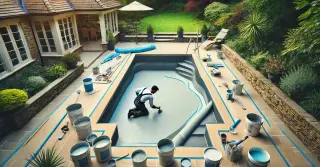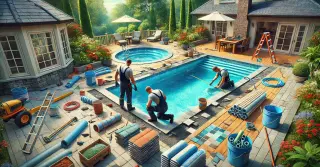Swimming Pool Resurfacing

Resurfacing your pool is a necessary maintenance procedure that ensures the longevity of the pool's structure and aesthetics. As time passes, pool surfaces can become worn, cracked, or discolored, harming both their usability and aesthetic. Consistent resurfacing keeps the pool safe, beautiful, and pleasant to use.
Selecting the Best Resurfacing MaterialAn important decision in the resurfacing process is picking the best material for your pool. Different materials provide various advantages, so considering your needs and preferences is important.
- Traditional Plaster: Plaster is a popular choice for pool resurfacing thanks to its cost-effectiveness and strength. It provides a smooth finish and comes in a range of colors. However, it does require more upkeep compared to other materials.
- Pebble Aggregate: Pebble surfaces offer a more natural and textured look. They are highly durable and slip-resistant, making them ideal for pools with heavy use. Pebble surfaces are also available in a variety of colors and blends, permitting a custom appearance.
- Quartz: Quartz surfaces blend plaster's sleekness with the robustness of pebble. They are very stain-resistant and etch-resistant, providing a long-lasting and low-maintenance option. Quartz finishes are available in many vibrant colors, adding elegance and style to your pool.
Understanding the Resurfacing ProcessThe pool resurfacing process includes several important steps to ensure a high-quality result. Understanding these steps can ensure you are prepared.
- Pool Draining and Surface Preparation: The first step in the resurfacing process is to drain the pool and getting the surface ready. This means removing the existing surface material and cleaning the pool thoroughly to ensure proper adhesion of the new material.
- Installation of the New Surface: After preparation is complete, the new surface is installed. This part of the process requires accuracy and expertise to ensure a flawless and even application. Professional installers use advanced tools and methods to deliver the best results.
- Curing the Surface and Refilling: After the new surface is applied, proper curing is essential. This requires letting the new surface harden and set for a specific period. After the curing process is finished, the pool is refilled with fresh water, and it is ready for use.
Swimming pool resurfacing is essential for maintaining your pool. By selecting the best materials, knowing the steps, and hiring experts, you can maintain a beautiful, functional, and safe pool.




